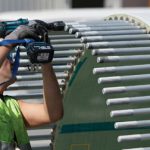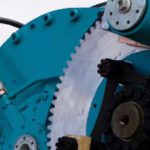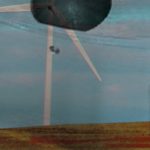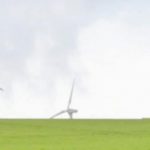As the warranty expiration date on your fleet of wind turbines approaches, there are many questions to be asked and a range of risk management options you should consider. This process needs to take place well in advance of the warranty expiration date to insure that all alternatives, including new third party warranty products, have been identified and carefully evaluated. Only then can you make the best financial and risk transfer decisions regarding the future of your machines. Figure 1
Possible strategies run the gamut from full limits five-year warranty extensions to completely assuming the risk on the operator’s balance sheet with no warranty coverage in place. The following is an analysis of wind turbine warranty exposures and the various strategies that can be employed to understand and manage these risks.
Typical warranty language reads as follows: The Seller warrants to the Buyer that during the Warranty Period: (i) the Equipment to be supplied hereunder shall (a) be designed and fit for the purpose of generating electric power when operated in accordance with the Seller’s specific operating instructions and, in the absence thereof, in accordance with Prudent Wind Industry Practices (b) be new and free from defects in material, workmanship and title, (c) comply with the Technical Specification and (ii) all Services to be performed hereunder shall be performed in a competent, diligent manner in accordance with the requirements of this Contract and any other mutually agreed specifications (collectively, the “Warranty”).
With the explosive growth of the wind turbine industry over the last five years there has been a year by year increase in the number of wind turbines coming out of their original OEM warranty. Compounding the issue of warranty expiration is the fact that more than 50 percent of the U.S. wind turbine fleet may be behind in scheduled maintenance. It has been estimated that ownership and maintenance costs can increase by as much as 250 percent over the 20-year life of the wind turbine. This lag in scheduled maintenance has resulted from a number of factors, including budget constraints and a lack of trained service technicians.
This statistic has larger ramifications to the wind farm operator than simply being behind a maintenance schedule. Almost all wind turbine supply agreements are very specific about both the maintenance schedule and who is to perform the work. In addition, the typical Turbine Supply Agreement (TSA) has very specific language regarding the exclusion of warranty claims if the maintenance performed and documentation of servicing of the turbines are not in accordance with the TSA.
Exclusionary language related to warranties in a typical TSA is as follows. The exposures and potential pitfalls related to service, maintenance and record keeping should be clear: The Seller does not warrant the Equipment or any repaired or replacement parts against normal wear and tear, including that due to environment or operation. The warranties and remedies set forth herein are further conditioned upon (i) the proper storage, installation, operation, and maintenance of the Equipment conformance with the operation instruction manuals (including revisions thereto) provided to Buyer by the Seller and/or its Subcontractors or Suppliers, as applicable and, (ii) the provision and maintenance throughout the Warranty Period of a T-1 line for remote monitoring as described in the Technical Specification, and (iii) repair or modification pursuant to the Seller’s instructions or approval. The Buyer shall keep proper records of operation and maintenance during the Warranty Period. These records shall be kept in the form of log sheets and copies shall be submitted to the Seller upon its request.
As turbines approach the end of their warranty period, it is therefore critical to put into effect a well thought out end of warranty strategy.
Independent Turbine Inspections
The first step should be sourcing an independent inspection of each and every turbine that is coming off warranty. It is critical that this inspection be done before the warranty ends for several reasons.
First, the owners will want to document all possible claims and submit them, via a Reservation of Rights letter, to the original equipment manufacturer (OEM) far enough in advance so the operator can negotiate any repairs directly with the OEM. This negotiation process can be time consuming and the wind farm owner will want to allow enough lead time so any needed repairs are completed before or shortly after the end of the OEM warranty period. Figure 2
The second reason the wind farm owner needs an independent inspection is for documentation purposes as to the condition of the wind turbine at the time of the warranty expiration. This documentation may be required for the wind farm’s lenders and will certainly be required by the insurance companies participating in the coverage of the wind farm.
It is also important to note that once this report is completed it will document the areas of concern on each and every turbine. If for some reason these documented issues are not addressed at the end of the warranty by the OEM or repaired by the wind farm owner, any future insurance claims stemming from these issues will be denied as resulting from a “pre-existing condition.”
Extended Warranty Coverage
Should I purchase extended warranty coverage or not, and what are my options if so? This is the question that is now being contemplated by over 20 percent of our country’s wind turbine owners as their assets become warranty liabilities.
The goods news is there are now third-party extended warranty options available in the insurance market place. Historically, extended warranty options were limited and typically provided by the wind turbine manufacturer. These warranties were usually negotiated at the time of wind turbine purchase and the standard warranty “built into” the sales price of the turbine was two years with a three year extension available for an additional per turbine, per year charge. Figure 3
Over the last 20 years, the length of warranties has decreased dramatically. As manufacturers built substantial liabilities on their own balance sheets and established their operations and maintenance (O&M) divisions, warranty periods were reduced and the sale of warranty extensions became a substantial profit center.
Warranty Options
Balance sheet finance: As the turbine warranties expire, the wind farm operator may decide to assume responsibility for 100 percent of the costs and losses resulting from warranty related incidents. Keep in mind that the true cost of a warranty occurrence is the combination of costs associated with securing the effected turbine, obtaining and shipping the replacement part, hiring and transporting the repair equipment, providing the labor for repairs, and assuming the lost income and production tax credits, if applicable. Historically, this has been the only option available to wind farm operators since the OEM’s did not offer extended warranties past the five-year period.
Rely on property insurance: Wind farm owners who choose to forgo extended warranty coverage believing their property insurance coverage will respond to a warranty claim are likely to be surprised when that claim is denied. While some property insurance policies provide a minimal amount of coverage as outlined below, a property policy will not provide the wind farm operator with complete warranty coverage. Unlike property policies that require losses to stem from a covered peril, a warranty policy does not require you to run your equipment until it breaks in order to have coverage.
Property forms do not provide warranty coverage and can be ambiguous with exclusions or limitations so losses are subject to underwriter’s acceptance or are left for attorneys to litigate. There are too many gray areas that leave projects exposed and put lenders and investors at risk. Here are some of the major differences between property policy coverage and warranty policy coverage. Property forms provide coverage for the peril of mechanical and electrical breakdown if the failure is sudden and accidental and subject to exclusions and limitations. Coverage is excluded under a property policy for the following:
• Defects or faults in material, workmanship, or design: As an example, blades are cracking due to faulty materials or bolts are not fastened properly during construction and nacelle falls off tower.
• Wear and tear: Cable brackets are failing due to a repetitive movement over a long period of time and the cables are splitting and arcing.
• Gradual deterioration: Bearings are grinding over a long period of time, which causes your gearboxes to fail.
• Inherent vice: There are hidden defects in the equipment or materials that cause deterioration and/or damage.
• Latent defects: There are hidden defects in material and/or workmanship not discoverable through general inspection.
• Serial losses have limited coverage under a property policy: Development of a defect in equipment indemnity would be: first item 100 percent; second item 75 percent; third item 50 percent; fourth item 25 percent; subsequent 0 percent.
Warranties have a positive impact on insurance premiums as they indemnify the equipment system owner in the event a product defect that leads to losses. They do not take the place of a warranty policy, however, and should not be counted on to do so.
Purchase extended warranty from the OEM: Extended warranties might be available in several forms from the OEMs. Depending upon who the wind farm operators are, the quantities of turbines with expiring warranties and the locations, the warranty offering might be parts only or may include parts and labor. These warranties are sold on a per-turbine, per-year basis and cover the full value of the turbines with little to no deductible. Pricing for the OEM warranties range anywhere from $30,000.00 per turbine per year for a 1.5MW turbine to over $150,000.00 per turbine per year for a 3 MW machine. Using the lower pricing range, a wind farm with 100 1.5MW machines electing to purchase a five-year warranty would incur costs of $15M. (100 Turbines x five years x $30,000 = $15,000,000 warranty bill).
Purchase a third party insurance warranty: Until very recently a viable, cost-effective third-party warranty option has not been available to the wind farm operator. Today’s third-party warranty product is designed to wrap around the turbine supply agreement (TSA) to continue the coverage supplied by the OEM. The third-party warranty product can be modified to cover additional risks or to modify the risks covered in the original TSA. The third-party warranty (written on A.M. Best Rated A XV paper) covers serial defect, product defect, availability, parts, and labor. Optional coverage for power curve and noise are also available and can be added to the third-party warranty by endorsement.
The third-party warranty is generally sold in “blocks” of limits that are usable for a five-year period. Unlike the OEM warranty, the third-party warranty minimum insurance limits required are calculated on a maximum probable loss (MPL) basis. This means that under reasonable conditions, taking into consideration the make, manufacturer, current condition, and loss record of the turbines, the limits required should cover the foreseeable loss.
Third-party warranties also have annual deductible structures similar to property policies. The final decision as to the amount of limits to be purchased is made by the wind farm owner and will ultimately determine the warranty price. Significantly, third-party warranty coverage can be purchased for far less than available OEM warranty options. Consider again our hypothetical wind farm with 100 1.5MW machines electing to purchase a five-year warranty:
• OEM Warranty Costs: 100 turbines x five years x $30,000. = $15,000,000 warranty bill;
• Third Party Warranty Costs: $10M in limits, usable up to the limits of the policy, for a five-year period = $3M warranty bill.
In this example, the wind farm operator would save an estimated $12M with the purchase of a third-party warranty policy, reducing warranty costs by 80 percent. This is clearly an option that must be understood and investigated by anyone with a financial interest in wind turbines approaching the end of initial OEM warranty.
One final word of advice. Providing warranty coverage of this nature is a highly specialized discipline having many nuances. Not everyone has the experience and the knowledge to fully understand the issues and to craft the necessary strategies and solutions. No single approach will be the right one for every situation. There is no “one size fits all.” Look for insurance and financial services advisors who have a strong background in the energy industry and work extensively with alternative approaches and emerging technologies. Otherwise, you may just find yourself twisting in the wind.








































